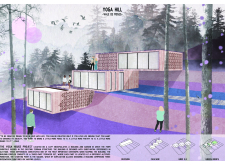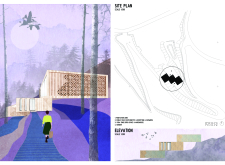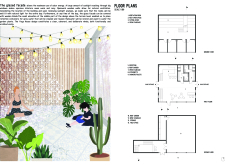5 key facts about this project
The building's primary function revolves around community engagement, providing spaces for gathering, learning, and recreational activities. It is designed to accommodate a variety of events, making it a versatile venue that promotes social interaction and fosters a sense of belonging among its users. The spatial layout efficiently organizes these functions, allowing ease of movement and accessibility while encouraging fluidity between indoor and outdoor areas.
A unique aspect of this architectural design is the way it utilizes natural light and ventilation. Large windows and strategically placed openings create a connection to the outside, inviting in sunlight while providing views of the surrounding landscape. This not only enhances the user experience but also reduces the dependency on artificial lighting and climate control systems, contributing to overall energy efficiency.
Material selection plays a pivotal role in the project, emphasizing sustainability and local context. The use of regional materials not only solidifies the building’s connection to its geographical location but also supports local economies. Materials such as sustainably sourced wood, recycled concrete, and low-carbon footprint glass are employed throughout the design. These choices are not only aesthetic but functional, providing durability and ensuring the building can withstand the test of time while minimizing environmental impact.
In addition to thoughtfully chosen materials, the architectural features of the project reflect a contemporary approach that marries form and function. The roof structure is designed with an emphasis on both aesthetics and practicality—integrating necessary systems for rainwater collection and green roof installations, which further augment the building’s ecological performance. This thoughtful integration of spaces allows for outdoor areas that can be used for a variety of purposes, from informal gatherings to organized events.
The design outcome is a building that does not merely occupy space but rather complements and enhances its environment. It fosters a sense of place and reinforces community identity. Furthermore, the architectural design incorporates local environmental considerations, adapting to the climate and geographical features unique to the region. This comprehensive approach not only improves the building's longevity but also exemplifies responsible architecture that respects its surroundings.
As readers explore this project further, they are encouraged to delve into architectural plans and sections that reveal the meticulous thought process behind the design. These documents illustrate the functional relationships and spatial dynamics within the project, providing invaluable insights into the architect's approach. Understanding these elements enhances appreciation for the architectural ideas that come to life through this project.
Ultimately, this architectural design stands as a testament to the balance between functionality, sustainability, and community engagement. For those interested in exploring the intricacies and thoughtful considerations involved in the project, further investigation into the presentation materials will yield a deeper understanding of the innovative architectural designs that define this engaging space.


























